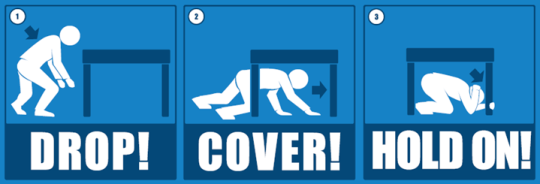Earthquake Information
In 2014, our area was reminded of the risk we face from earthquakes in the North Bay area when many of us were awoken by the Napa Earthquake. While SSU was fortunate to have not sustained damage, many of our neighbors, including faculty, staff and students, were less fortunate. More than 200 people were injured and one person died. Injuries were mostly caused by falling debris and people attempting to run to safety during or immediately after the shaking.
When an earthquake strikes, the proper response is to:

- DROP to the ground
- COVER your head and neck with your arms and seek additional shelter by getting under a sturdy desk or table IF one is nearby; and
- HOLD ON to your shelter and be prepared to move with it until the shaking stop; if you are not under a shelter, hold on to your head until the shaking stops.
This video shows the appropriate steps to take to Drop, Cover, and Hold On. If there are no tables or sturdy objects around you, this video will explain what to do.
Please note: The videos referenced in the prior section and the in the section below are not captioned. This video is open captioned and narrated with sign language. Additional accessible materials can be found by visiting the Earthquake Country Alliance website.
Did you know?
The following situations may require adaption to "Drop, Cover, and Hold On". It is best to be familiar with these alternate choices since earthquakes can strike anytime!
What if I am...
- Unable to drop and cover or I'm disabled?
Visit Earthquake Country Alliance's website for recommendations for people who use wheelchairs, walkers, or are unable to drop to the ground and get up again without assistance. - Indoors?
Drop, Cover, and Hold On. Avoid exterior walls, windows, hanging objects, mirrors, tall furniture, large appliances, and kitchen cabinets with heavy objects or glass. However, do not try to move more than 5-7 feet before getting on the ground. Do not go outside during shaking! The area near the exterior walls of a building is the most dangerous place to be. Windows, facades and architectural details are often the first parts of the building to break away. If seated and unable to drop to the floor: bend forward, Cover your head with your arms, and Hold On to your neck with both hands. - In bed?
Do not get out of bed. Lie face down to protect vital organs, and Cover your head and neck with a pillow, keeping your arms as close to your head as possible, while you Hold On to your head and neck with both hands until shaking stops. You are less likely to be injured by fallen and broken objects by staying where you are. - In a high rise building?
Drop, Cover, and Hold On. Avoid windows and other hazards. Do not use elevators. Do not be surprised if sprinkler systems or fire alarms activate. - In a store?
Drop, Cover, and Hold On. Getting next to a shopping cart, beneath clothing racks, or within the first level of warehouse racks may provide extra protection. - Outdoors?
Move to a clear area if you can safely do so; avoid power lines, trees, signs, buildings, vehicles, and other hazards. Then Drop, Cover, and Hold On. This protects you from any objects that may be thrown from the side, even if nothing is directly above you. - Driving?
See Driving Video – Pull over to the side of the road, stop, and set the parking brake. Avoid overpasses, bridges, power lines, signs and other hazards. Stay inside the vehicle until the shaking stops, then proceed carefully by avoiding fallen debris, cracked or shifted payment, and emergency vehicles. If a power line falls on the car, stay inside until a trained person removes the wire. - In a stadium or theater?
See Stadium or Theater Video – Drop to the ground in front of your seat or lean over as much as possible, then Cover your head with your arms (as best as possible), and Hold On to your neck with both hands until shaking stops. Then walk out slowly, watching for anything that could fall during aftershocks. - Near the shore or at the beach?
Follow instructions above for your particular location. Then as soon as shaking reduces such that you are able to stand, walk quickly to high ground or inland as a tsunami may arrive soon. Don't wait for officials to issue a warning. Walk, rather than drive, to avoid traffic, debris, and other hazards.

